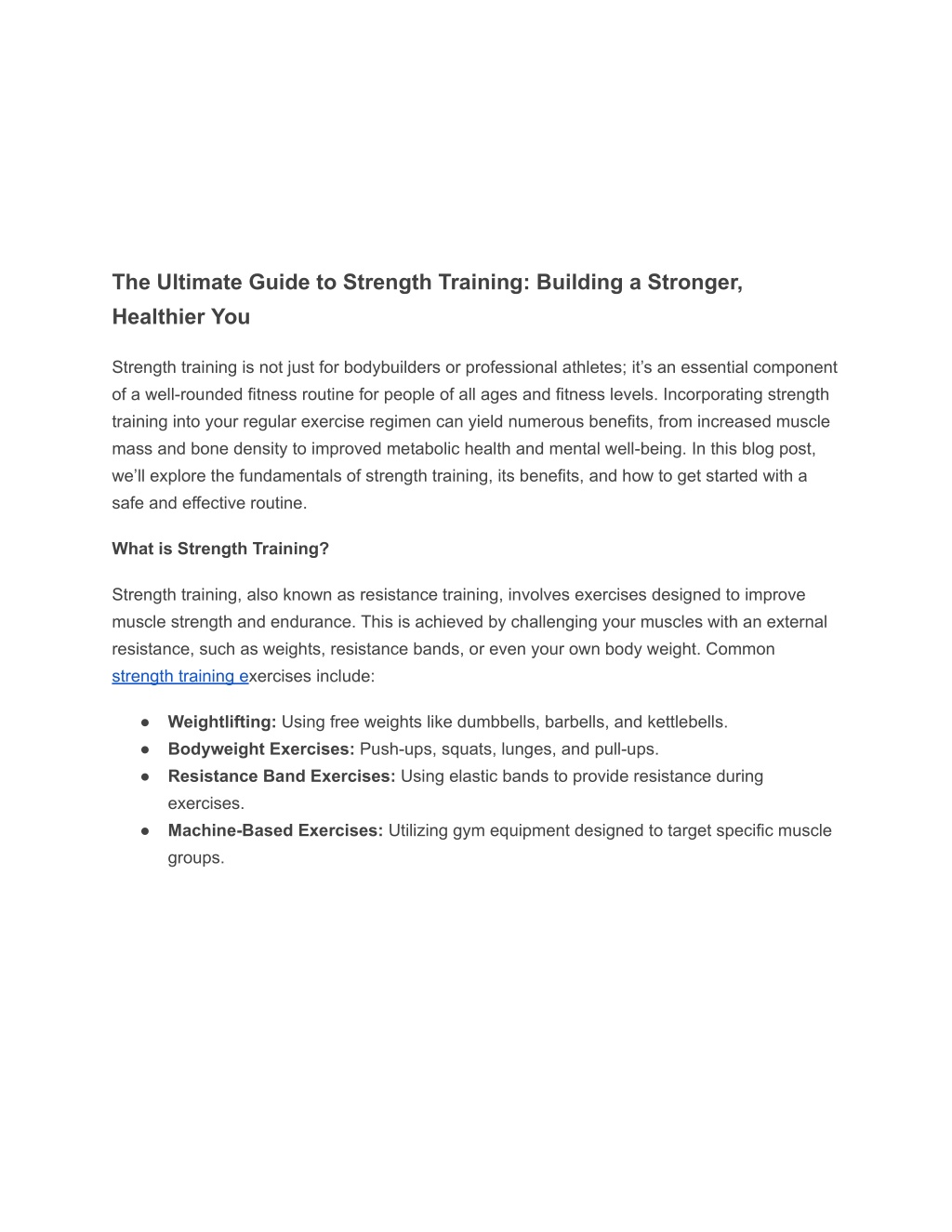
strength_and_training1
Committed to promoting wellness through fitness and nutrition, I advocate for a balanced lifestyle that enhances both physical and mental well-being. With a passion for helping others achieve their health goals, I offer personalized guidance and supp
Download Presentation

Please find below an Image/Link to download the presentation.
The content on the website is provided AS IS for your information and personal use only. It may not be sold, licensed, or shared on other websites without obtaining consent from the author. Download presentation by click this link. If you encounter any issues during the download, it is possible that the publisher has removed the file from their server.
E N D
Presentation Transcript
The Ultimate Guide to Strength Training: Building a Stronger, Healthier You Strength training is not just for bodybuilders or professional athletes; it s an essential component of a well-rounded fitness routine for people of all ages and fitness levels. Incorporating strength training into your regular exercise regimen can yield numerous benefits, from increased muscle mass and bone density to improved metabolic health and mental well-being. In this blog post, we ll explore the fundamentals of strength training, its benefits, and how to get started with a safe and effective routine. What is Strength Training? Strength training, also known as resistance training, involves exercises designed to improve muscle strength and endurance. This is achieved by challenging your muscles with an external resistance, such as weights, resistance bands, or even your own body weight. Common strength training exercises include: Weightlifting: Using free weights like dumbbells, barbells, and kettlebells. Bodyweight Exercises: Push-ups, squats, lunges, and pull-ups. Resistance Band Exercises: Using elastic bands to provide resistance during exercises. Machine-Based Exercises: Utilizing gym equipment designed to target specific muscle groups.
1. Increased Muscle Mass and Strength: Regular strength training helps build and maintain muscle mass, which is essential for overall strength and physical performance. 2. Enhanced Bone Health: Weight-bearing exercises stimulate bone growth and increase bone density, reducing the risk of osteoporosis. 3. Improved Metabolic Health: Strength training boosts your metabolism, helping you burn more calories even at rest. It also helps regulate blood sugar levels and improve insulin sensitivity. 4. Better Joint Function and Flexibility: Strengthening the muscles around your joints provides better support and stability, reducing the risk of injuries. 5. Mental Health Benefits: Exercise, including strength training, releases endorphins, which can help reduce symptoms of anxiety and depression. It also enhances cognitive function and reduces the risk of age-related cognitive decline. 6. Increased Functional Fitness: Strength training improves your ability to perform everyday activities, from lifting groceries to climbing stairs, with ease and confidence. Getting Started with Strength Training 1. Consult with a Professional: Before starting any new exercise program, especially if you have existing health conditions or concerns, it s wise to consult with a healthcare provider or a certified fitness trainer. 2. Start with a Plan: Develop a balanced strength training routine that targets all major muscle groups. Aim for at least two to three sessions per week, allowing for rest and recovery between workouts. 3. Focus on Proper Form: Good form is crucial to prevent injuries and ensure you re effectively working your muscles. Consider working with a trainer to learn proper techniques, especially if you re new to strength training. 4. Progress Gradually: Begin with lighter weights or resistance and gradually increase the intensity as you build strength and confidence. Listen to your body and avoid overtraining. 5. Incorporate Variety: Keep your workouts interesting and challenging by incorporating different exercises, equipment, and routines. This also helps prevent plateaus and promotes balanced muscle development. 6. Stay Consistent: Consistency is key to seeing results. Make strength training a regular part of your fitness routine and stay committed to your goals. Sample Beginner Strength Training Routine
Heres a simple strength training routine to get you started. Perform each exercise for 2-3 sets of 10-15 repetitions. 1. Bodyweight Squats 2. Push-Ups 3. Bent-Over Rows (using dumbbells or resistance bands) 4. Plank Holds 5. Lunges 6. Shoulder Press (using dumbbells or resistance bands) Conclusion Strength training is a powerful tool for improving your physical and mental health, enhancing your quality of life, and achieving your fitness goals. Whether you re lifting weights at the gym or doing bodyweight exercises at home, the key is to stay consistent, focus on proper form, and enjoy the journey toward a stronger, healthier you. Start today and experience the transformative benefits of strength training!






















